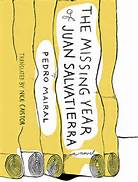Book Review: “The Missing Year of Juan Salvatierra” — A River of Consciousness
The Missing Year of Juan Salvatierra by Pedro Mairal. Translated from the Spanish by Nick Caistor. New Vessel Press, 118 pages, 15.49 print, $9.99 ebook.
By Bill Marx
An enjoyably ironic fable about the boundless ambition and inevitable vulnerability of the imagination, The Missing Year of Juan Salvatierra by Argentinian writer Pedro Mairal, translated from the Spanish by Nick Caistor, revolves around the fate of a gargantuan painting, an epic stream of consciousness in oils that reflects six decades of day-to-day existence in the life of artist Juan Salvatierra, who is dead when this short novel, which is set in a small village along the border of Argentina and Uruguay, begins.
Speechless since the age of nine after a freak accident, Salvatierra spent much of time (outside of his job at the post office) painting the scrolls, a spectacular means of communication that he was indifferent about sharing with the public. One parchment continues on from the other: the result is a fantastical tapestry that compounds fact and dream, a gigantic surreal loop that is over two miles long at his death. Mairal is less interested in supplying a detailed portrait of the heroic artist than exploring the considerable problems, emotional and practical, posed by his art and its legacy to his two somewhat emotionally stunted sons. The scrolls are housed in a shed that stands on land a possibly shady local businessman covets, and there is a missing year in the painting, a lacuna that bedevils one of the sons, who embarks on a mission to find the scroll while representatives from a Dutch museum video-tape the entire painting before having the mother load shipped abroad for an exhibition. Complications ensue . . .
The mystery aspect of the book is the least compelling—it is no surprise that the self-involved Salvatierra lived a clandestine existence. The didactic significance of the content of the “missing year” is also somewhat obvious, given its intimate connections with marginal people and lives. The two sons form too neat a metaphorical contrast—the book’s narrator is a warily empathetic sibling, smarting from the breakup of his family, while the other is coolly rational. Yet The Missing Year of Juan Salvatierra is a engaging celebration of art as a force of nature, the fragile yet indomitable demand for possibility despite the constraints of a torpid existence. Salvatierra’s mighty painting emerges as a fascinating figure in the book, an omnivorous canvas whose hungry vision smashes through constrictions, from the political to the metaphysical.
Possibly because of this sense of the limitless flow of nature that the canvas had, I find it hard to call it a painting, because that suggests a frame, a border that surrounds certain things, and that’s precisely what Salvatierra wanted to avoid. He was fascinated by the lack of a limit, of a boundary, by the way different spaces communicated with one another. Boundaries are suppressed in his work: each being is at the mercy of all the others, trapped within the cruelty of nature. They are all prey. Even the humans.
Smoothly translated by Nick Caistor, The Missing Year of Juan Salvatierra celebrates the absurd life and paradoxical death of a world elsewhere.
Tagged: New Vessel Press, Nick Caistor, Pedro Mairal, The Missing Year of Juan Salvatierra

